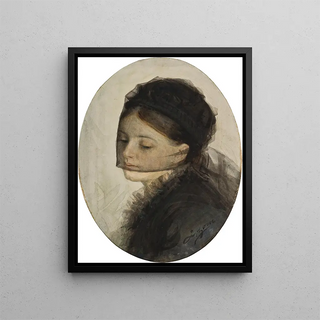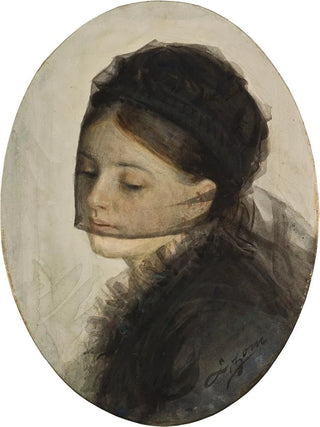Art print | Mourning - Anders Zorn


View from behind

Frame (optional)
Anders Zorn's "En deuil" is a masterpiece that evokes deep emotions and rare artistic sensitivity. Painted at the end of the 19th century, this artwork demonstrates Zorn's mastery in portrait art, while capturing an atmosphere of melancholy and reflection. Through this art print, viewers are invited to immerse themselves in a universe where light and shadow intertwine, revealing the subtleties of human feelings. The posture of the central figure, imbued with sadness, evokes a moment of introspection that resonates with anyone who has experienced loss. Thus, "En deuil" is not just a simple painting, but becomes a mirror of emotions, a space for dialogue between the artist and the viewer.
Style and uniqueness of the work
Anders Zorn's style is often characterized by striking realism, meticulous attention to detail, and masterful use of light. In "En deuil", Zorn deploys his talents to create an atmosphere charged with emotion. The dark tones and pronounced contrasts reinforce the feeling of solitude and sadness emanating from the canvas. The texture of the paint, both soft and vibrant, allows one to feel the depth of the subject's feelings. Zorn manages to capture not only the physical appearance of his model but also the state of mind that inhabits them. Every brushstroke seems to tell a story, and every shade of color contributes to expressing this poignant melancholy. The work stands out for its ability to transcend time and touch the soul of those who contemplate it.
The artist and his influence
Anders Zorn, born in 1860 in Sweden, is one of the most influential artists of his time. Raised in an artistic environment, he quickly develops a unique style that combines tradition and innovation. Zorn is recognized for his portraits, landscapes, and scenes of everyday life, but it is in his representations of the human figure that he excels particularly. Influenced by great masters of painting, such as Rembrandt and Velázquez, he manages to create a visual signature that is uniquely his own.

Matte finish

View from behind

Frame (optional)
Anders Zorn's "En deuil" is a masterpiece that evokes deep emotions and rare artistic sensitivity. Painted at the end of the 19th century, this artwork demonstrates Zorn's mastery in portrait art, while capturing an atmosphere of melancholy and reflection. Through this art print, viewers are invited to immerse themselves in a universe where light and shadow intertwine, revealing the subtleties of human feelings. The posture of the central figure, imbued with sadness, evokes a moment of introspection that resonates with anyone who has experienced loss. Thus, "En deuil" is not just a simple painting, but becomes a mirror of emotions, a space for dialogue between the artist and the viewer.
Style and uniqueness of the work
Anders Zorn's style is often characterized by striking realism, meticulous attention to detail, and masterful use of light. In "En deuil", Zorn deploys his talents to create an atmosphere charged with emotion. The dark tones and pronounced contrasts reinforce the feeling of solitude and sadness emanating from the canvas. The texture of the paint, both soft and vibrant, allows one to feel the depth of the subject's feelings. Zorn manages to capture not only the physical appearance of his model but also the state of mind that inhabits them. Every brushstroke seems to tell a story, and every shade of color contributes to expressing this poignant melancholy. The work stands out for its ability to transcend time and touch the soul of those who contemplate it.
The artist and his influence
Anders Zorn, born in 1860 in Sweden, is one of the most influential artists of his time. Raised in an artistic environment, he quickly develops a unique style that combines tradition and innovation. Zorn is recognized for his portraits, landscapes, and scenes of everyday life, but it is in his representations of the human figure that he excels particularly. Influenced by great masters of painting, such as Rembrandt and Velázquez, he manages to create a visual signature that is uniquely his own.






